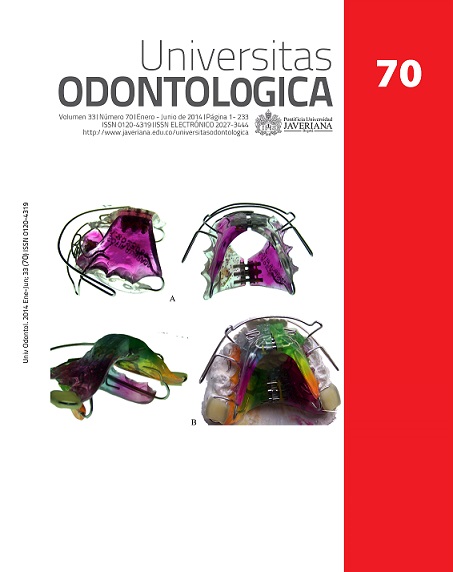Abstract
Background: The discovery of RANKL-RANK-OPG has favored advancing in the study of signaling for skeletal homeostasis. The function of this molecular system has not been proven yet in relation to the orthodontic dental movement. Purpose: To determine the levels of receptor activator of nuclear factor kappa-B ligand (RANKL) and osteoprotegerin (OPG) in the tension area of teeth subjected to orthodontic forces. Methods: A sample of 37 premolars (21, experimental group; 16, control group) was analyzed. The experimental group was divided into two groups that received two different forces (4 oz, 7 oz), in two time periods (24 hours and 7 days). The control group was submitted to no force. Periodontal ligament was obtained from the tension area and the RANKL and OPG levels were measured through ELISA (R&D System). The statistical analysis was performed using ANOVA and the Kruskal-Wallis test. Results: RANKL levels of the experimental group were statistically significant after 24 hours of stimulation with orthodontic forces. The average values of OPG were similar in both groups. Conclusions: The expression of RANKL and OPG in the tension area takes place in different ways depending on the magnitude and duration of the force applied during the orthodontic dental movement.
KEYWORDS
RANKL; RANK; OPG; orthodontic dental movement; tension area; orthodontic force
This journal is registered under a Creative Commons Attribution 4.0 International Public License. Thus, this work may be reproduced, distributed, and publicly shared in digital format, as long as the names of the authors and Pontificia Universidad Javeriana are acknowledged. Others are allowed to quote, adapt, transform, auto-archive, republish, and create based on this material, for any purpose (even commercial ones), provided the authorship is duly acknowledged, a link to the original work is provided, and it is specified if changes have been made. Pontificia Universidad Javeriana does not hold the rights of published works and the authors are solely responsible for the contents of their works; they keep the moral, intellectual, privacy, and publicity rights.
Approving the intervention of the work (review, copy-editing, translation, layout) and the following outreach, are granted through an use license and not through an assignment of rights. This means the journal and Pontificia Universidad Javeriana cannot be held responsible for any ethical malpractice by the authors. As a consequence of the protection granted by the use license, the journal is not required to publish recantations or modify information already published, unless the errata stems from the editorial management process. Publishing contents in this journal does not generate royalties for contributors.


